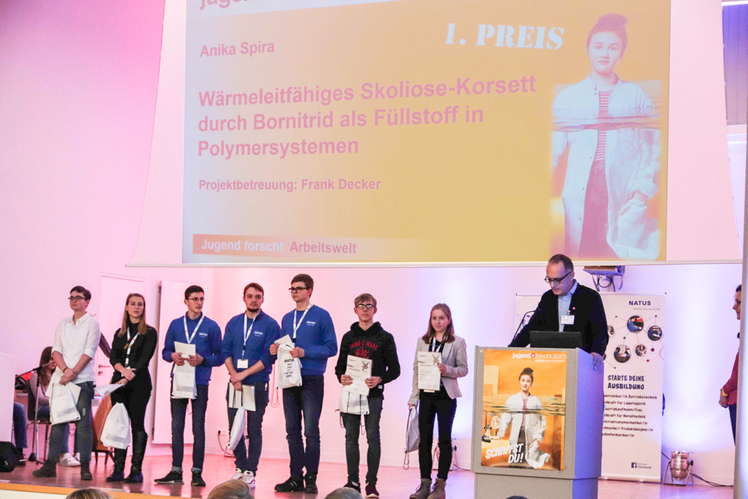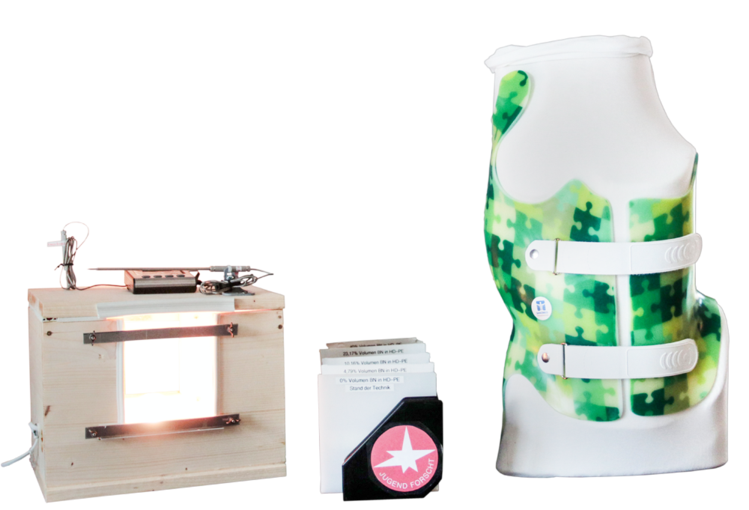Mission accomplished: excellent thermal conductivity
Thermally conductive scoliosis braces made of polymer systems with a boron nitride filler
Customised scoliosis braces are used to counteract deformities of the spine at an early stage. The only problem is that they’re poor conductors of body heat – yet they must be worn permanently. Anika Spira, a 16-year-old student from Bad Sobernheim, has come up with a solution that significantly improves the comfort of scoliosis braces, especially during the warmer season.
Scoliosis is the term used to describe deformities of the spine, where lateral curvatures are usually accompanied by twists in the area of the thoracic or lumbar spine. When they’re more pronounced, these often lead to permanent pain – mostly as a result of muscular tension. Scoliosis occurs particularly frequently during growth-intensive phases in children and adolescents. To counteract the development of deformities, special scoliosis braces are increasingly being used as a form of treatment. These braces can be individually adjusted to the shape of the patient's back by orthopedic technicians to guide the future growth process so that scoliosis is counteracted.
Anika Spira was 14 years old when a routine examination revealed that she had a curvature of the spine. Although it did ease her back pain, the plastic brace became a problem in itself, especially during the warmer seasons. In order for the wearer to benefit fully from the medical effects of the brace, they should wear it for at least 23 hours a day. Spira says, “When temperatures start exceeding 25 degrees from May onwards, wearing it becomes quite unbearable, especially when I’m participating in sports or when we go on outings.” The result is that “my skin used to turn red at the points of contact and I developed painful bruises.”
On the occasion of the annual Girls’ Day, this pupil of the Emanuel Felke grammar school in Bad Sobernheim in the Rhineland-Palatinate region of Germany decided to take control of her own destiny and went to see an orthopedic technician. “At first I was amazed at how much engineering is involved in such a brace. But later I started to wonder why it was made entirely of plastic. Polymers have rather weak thermal conductivity and are therefore very slow to release body heat to the outside. When I spoke to the technician, it became clear to me that the problem of heat build-up had never even been considered before.”
Spira started by investigating raw materials. After having excluded a whole range of materials, she stumbled “quite by accident” across boron nitride – a substance that she had never heard of before – during the course of her research. It quickly became clear to her that boron nitride in its white, powdered form fulfilled her requirements for a material in all ways – it’s light, very stable and, above all, has excellent thermal conductivity. This makes it a popular choice as a filler in polymer compounds. Depending on the requirement or application, it can maximise heat transfer in a diversity of forms, compound formulations and processing technologies. Compounds filled with boron nitride have a thermal conductivity that’s five to twenty times higher than that of materials made of pure plastic. In addition, boron nitride has another special strength: due to its consistency, it’s also highly suitable for industrial processing – because there’s minimal wear of the tools.
The next step was to obtain further important information from the practice to validate her theory. In her father, she found a partner who supported her enthusiastically in this quest. Furthermore, the orthopedic technician and the plastic sheet manufacturer were both located close to the family’s home. “To assist my daughter, I made the initial contact with them,” says Jens Spira. “Later, in order to obtain more detailed information on boron nitride, we contacted a multi-technology company in Kempten that produces high-performance ceramics.” This made it possible for Anika to obtain further information, which ultimately confirmed her belief that in boron nitride she had found the ideal filler material for the brace.
In order to produce tangible results, she then needed to convert what was a promising idea into a working solution. Most importantly, she wanted to ascertain how the higher degree of thermal conductivity would actually impact the comfort of the wearer. Says Spira, “Boron nitride is significantly more expensive to buy than plastic. That meant that the less we needed the better. Added to this was the technical cost involved in producing a prototype brace. It was therefore still too expensive for us to manufacture a prototype at that stage. However, we managed to persuade another company to manufacture plastic plates containing different levels of boron nitride for us.”
In order to test the effect of the individual test plates on thermal conductivity, Spira and her father built a climatic chamber. The respective test plate could be inserted as a wall on one side of a wooden box, which was equipped with a 60W light bulb to serve as heat source. This allowed them to measure heat absorption and thermal conductivity on the inside and outside of the plate. In addition to the results of these measurements, other factors that could arise from changing the boron nitride content could be investigated. “Larger proportions of boron nitride make the plastic brittle. That was of course counterproductive, because we needed the most flexible basic material possible – if for nothing else, because of the adjustments that need to be made.” This meant that they had to find a compromise between the thermal conductivity of the compounds and the degree of flexibility that would ensure the greatest comfort.
The regional youth science competition “Jugend forscht” was exactly the stage Spira needed to promote her project, and she entered her invention in November 2019. The title of her project was: “Thermally conductive scoliosis braces made of polymer systems with a boron nitride filler”. Not long after this, she hired a lawyer to file a patent with the German Patent and Trademark Office for the manufacture of a thermally conductive brace.
On February 14, 2020, she presented her project in person at the “Jugend forscht” event in Trier. The result? “Simply outstanding” – she placed first in the category “World of work”. Spira’s research project also received a special award for best entry and for including “special interdisciplinary elements”.
The case of this young researcher shows that nothing is quite as motivating as the taste of success. Spira says, “My next goal is to create a prototype with the support of the companies we have brought on board. I hope that we can start manufacturing the new braces early in 2021 – that would simply be a dream come true!”
Hollow glass bubbles as lightweight fillers - does this interest you?

The right additive intelligently selected for the base material creates real added value in product development.
- Weight reduction
- Thermal insulation
- Recyclability
The outstanding properties of 3M™ Glass Bubbles enable a wide range of applications.
Learn more about using hollow glass microspheres as lightweight fillers.
Find out more and get in touch with us: 3M Glass Bubbles
Please click here for the Product catalogue



